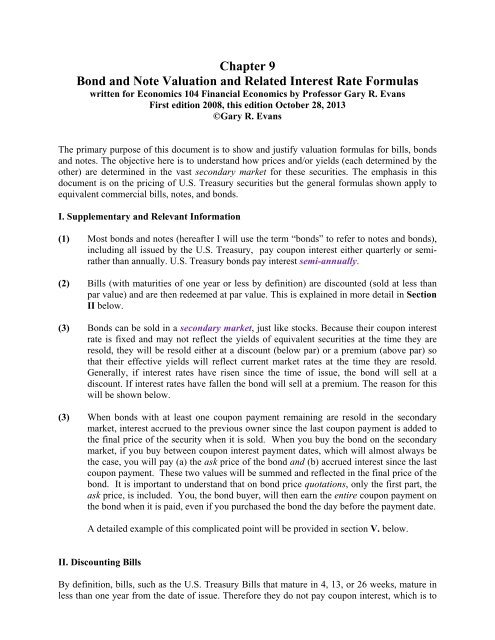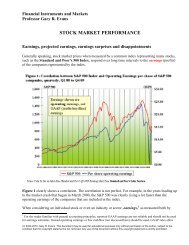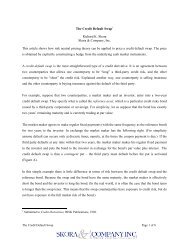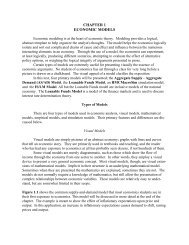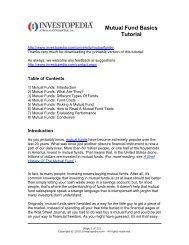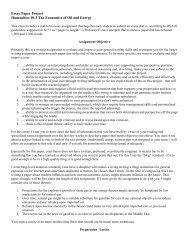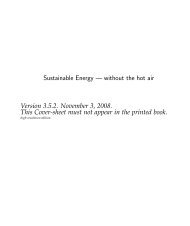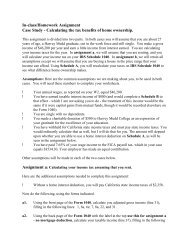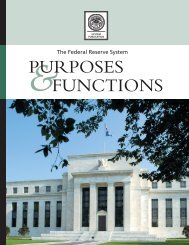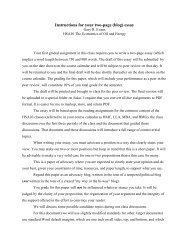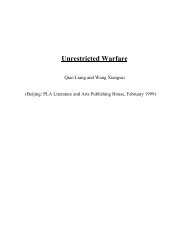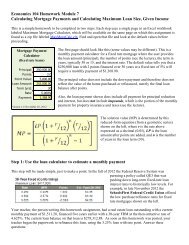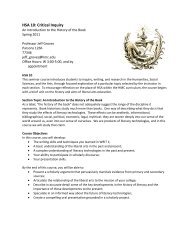Bond and Note Valuation and Related Interest Rate Formulas
Bond and Note Valuation and Related Interest Rate Formulas
Bond and Note Valuation and Related Interest Rate Formulas
You also want an ePaper? Increase the reach of your titles
YUMPU automatically turns print PDFs into web optimized ePapers that Google loves.
Chapter 9<strong>Bond</strong> <strong>and</strong> <strong>Note</strong> <strong>Valuation</strong> <strong>and</strong> <strong>Related</strong> <strong>Interest</strong> <strong>Rate</strong> <strong>Formulas</strong>written for Economics 104 Financial Economics by Professor Gary R. EvansFirst edition 2008, this edition October 28, 2013©Gary R. EvansThe primary purpose of this document is to show <strong>and</strong> justify valuation formulas for bills, bonds<strong>and</strong> notes. The objective here is to underst<strong>and</strong> how prices <strong>and</strong>/or yields (each determined by theother) are determined in the vast secondary market for these securities. The emphasis in thisdocument is on the pricing of U.S. Treasury securities but the general formulas shown apply toequivalent commercial bills, notes, <strong>and</strong> bonds.I. Supplementary <strong>and</strong> Relevant Information(1) Most bonds <strong>and</strong> notes (hereafter I will use the term “bonds” to refer to notes <strong>and</strong> bonds),including all issued by the U.S. Treasury, pay coupon interest either quarterly or semiratherthan annually. U.S. Treasury bonds pay interest semi-annually.(2) Bills (with maturities of one year or less by definition) are discounted (sold at less thanpar value) <strong>and</strong> are then redeemed at par value. This is explained in more detail in SectionII below.(3) <strong>Bond</strong>s can be sold in a secondary market, just like stocks. Because their coupon interestrate is fixed <strong>and</strong> may not reflect the yields of equivalent securities at the time they areresold, they will be resold either at a discount (below par) or a premium (above par) sothat their effective yields will reflect current market rates at the time they are resold.Generally, if interest rates have risen since the time of issue, the bond will sell at adiscount. If interest rates have fallen the bond will sell at a premium. The reason for thiswill be shown below.(3) When bonds with at least one coupon payment remaining are resold in the secondarymarket, interest accrued to the previous owner since the last coupon payment is added tothe final price of the security when it is sold. When you buy the bond on the secondarymarket, if you buy between coupon interest payment dates, which will almost always bethe case, you will pay (a) the ask price of the bond <strong>and</strong> (b) accrued interest since the lastcoupon payment. These two values will be summed <strong>and</strong> reflected in the final price of thebond. It is important to underst<strong>and</strong> that on bond price quotations, only the first part, theask price, is included. You, the bond buyer, will then earn the entire coupon payment onthe bond when it is paid, even if you purchased the bond the day before the payment date.A detailed example of this complicated point will be provided in section V. below.II. Discounting BillsBy definition, bills, such as the U.S. Treasury Bills that mature in 4, 13, or 26 weeks, mature inless than one year from the date of issue. Therefore they do not pay coupon interest, which is to
<strong>Bond</strong> <strong>Valuation</strong> - Page 2say that no separate interest payment is made to the investor. Instead they are sold at discount, aprice that is less than par, their redemption value. <strong>Interest</strong> earned for a bill is implicit in thecapital gain realized by buying the bill at discount <strong>and</strong> redeeming it at par.Although bills (<strong>and</strong> bonds) are sold in amounts that are multiples of $1,000, their prices arequoted in units of 100, which is called the par value. For example, a bill with a redemption valueof $10,000 currently quoted at 98.72 (discount) has a current value of $9,872. When the bill isredeemed it will be redeemed at par for $10,000. Therefore, although no interest payment wasever made for this bill, interest is implicit in the capital gain realized.The formula for determining the annualized discount yield of a bill when the discounted price isknown is shown here:1.100 price 52yield price weeks to maturityUsing the example above <strong>and</strong> assuming the bill to be a newly-issued U.S. Treasury Bill with aprice of 99.02 <strong>and</strong> a 13 week maturity, the discount yield will equal100 99.02 522. yield 0. 0395999.02 13The formula for determining the price of a bill with any given number of weeks to maturity(nwtm) when the discount yield is known (<strong>and</strong> confirming equation 2) is3.price 100nwtm yield 52 100 99.02 13 1 0.03959 1 52 The time-adjustment coefficient in the formulas above assume that the bill in question has aduration expressed in weeks. If the duration is expressed in months, then the coefficient is equalto the number of months duration divided by 12 <strong>and</strong> if expressed in days, the coefficient is equalto the number of days duration divided by 365. For example, a bill maturing in 24 days priced at99.745 would be have a yield of100 99.745 3654. yield 0. 038999.745 24
<strong>Bond</strong> <strong>Valuation</strong> - Page 3III. Compounding BasicsIn order to underst<strong>and</strong> the complicated bond valuation formula, we will build the explanation insteps. We will start by reviewing the basic formulas for calculating compound interest. This willbe easy to do in a question <strong>and</strong> answer format.Q: If I invest $10 at an annual rate of 8% for one year, what will my investment be worth atthe end of the year:A: $ 101.08$10. 80Q: What if I leave my interest earned in the account <strong>and</strong> let it accrue interest for two moreyears? What will my investment be worth at the end of the third year?3A: $10 1.08 $12. 60From this we generalize an interest-compounding formula, assuming a constant interest rate overa number of years <strong>and</strong> assuming the accrued interest (interest earned over the years) is left in theaccount.5. X X 1 r nfpX f = future value of investment,X p = present value of investment,r = the annual interest rate, <strong>and</strong>n = number of years of the investment.IV. Present Value BasicsNow let us change the orientation somewhat. In the series above, we wanted to know the futurevalues of investments placed today. Suppose we now want to instead know the present value ofsome known cash payment that will be paid in the future. Suppose, for example, that someonehas given you a contract promising to pay exactly $10,000 in 10 years. What is that contractworth today?Q: Isn’t that contract worth $10,000?A: No, clearly not. If you were given the option of accepting $10,000 today versus $10,000in 10 years, would you accept the former or the latter? Clearly you would accept theformer, if for no other reason than the fact that you could accept $10,000 today <strong>and</strong> invest
<strong>Bond</strong> <strong>Valuation</strong> - Page 4it at 8% (or the prevailing interest rate) for 10 years <strong>and</strong>, using formula (5) above, end upwith $21,590. So $10,000 to be paid 10 years in the future is worth a lot less than$10,000 to be paid today.Q: So how would I calculate the present value of $10,000 to be paid 10 years from now?A: Given the prevailing market interest rate on 10 year investments (usually this would be anestimate - let’s assume 8% for this example) we have to ask a related question: If I canexpect to earn 8% per year over the next 10 years <strong>and</strong> I want to have $10,000 at the endof that period, how much must I invest today? What initial investment earning 8%compounded annually will leave me with $10,000 after 10 years?To answer this, all we have to do is look back up to equation (5) <strong>and</strong> see that we can modify thatequation solving for the present value of X p using the future value X f over n years to get theanswer:6.XpXf 10,000n1 r 1.0810 $4,631.93This means that $4,631.93 invested at 8% compounded over 10 years will be worth exactly$10,000 at the end of the ten years, making the value financially equal, so a contract offering topay $10,000 in 10 years would be valued today at $4,631.94 given our assumptions aboutinterest rates.Q: Please clarify that last point. Why is the interest rate used in the calculation beingassumed or estimated?A: In some cases the interest rate would be known, but because interest rates can changeover time, because some investment alternatives are available that offer different rates(e.g. investing in Treasury bills vs. depositing in a bank), <strong>and</strong> the problem projects intothe future, sometimes an interest-rate estimate must be used. In most cases, the“prevailing market rate” on similar or identical alternative investments would be used.V. An Example of Present Value Applications - The California LotteryA good example of the present-value application to financial flows over the future can beprovided by the California lottery. Winners of the California lottery are not paid one lump sumwhen they win. They are paid in 20 equal annual payments, the first right after winning thelottery <strong>and</strong> the last 19 years later. For example, if you win $10 million, you are paid $500thous<strong>and</strong> right away <strong>and</strong> the same amount each year for the next 19 years.From the discussion just concluded, it is clear that the amount won is not really “worth” $10
<strong>Bond</strong> <strong>Valuation</strong> - Page 5million because so much of it is paid in the future <strong>and</strong> the lottery-winner gets no interest. Howmuch, then, is it worth? What, in other words, is the present value of this lottery win?At first glance this is clearly a more difficult problem than the problem represented in equation(6), which involved the present value of only one payment. In this problem there are 20payments.The solution here becomes easy to grasp as soon as we realize that when a payment streamincludes more than a single payment, the present value of those payments will be equal to thesummed present value of each individual payment. In the case of our lottery example, the presentvalue of a win is equal to the present value of each of the individual 20 annual payments,summed:7.500k500k500kValue 500k500k 0 1912181.08 1.08 1.08 1.08 1.08$5,301,800Expressing the same in summation notation:8.Value 19500kt0 1tr $5,301,800In a few words, the true value of winning $20 million in the California lottery, if we can assumethe prevailing interest rate to be 8%, is $5,301,800.VI. Elementary <strong>Bond</strong> <strong>Valuation</strong> - a Starting PointEvaluating a bond in many respects is not much different than giving a value to winning theCalifornia lottery. In the eyes of the finance markets a note or bond, whether newly issued orbeing resold on the secondary markets, is very little more than a future cash-payment stream.For example, a newly-issued 30-year bond paying interest once per year is a promise to pay (a)30 equal annual interest payments over 30 years, <strong>and</strong> (b) the bond’s par value (100) in exactly 30years. This is much like the California lottery payment, except the first payment is made at theend of the year instead of immediately, <strong>and</strong> in the case of the bond, the par value of the bond isredeemed at the end of the 30 years, resulting in one large final payment with a value equal topar.In is important to underst<strong>and</strong> that in the application below, we are using the formula to evaluatethe value of a bond on secondary market for a bond that was issued in the past at a time wheninterest rates were higher or lower.Suppose we are pricing the hypothetical bond discussed above - a 30-year bond paying interestonly once a year. Assume, as always, that the bond has a par value of 100 <strong>and</strong> a coupon rate of
<strong>Bond</strong> <strong>Valuation</strong> - Page 68% per year. This means, of course, that the bond pays $8 interest per year (per 100). Supposeadditionally, that 10 years have elapsed since the original issue of the bond, leaving only 20years to maturity (exactly). Finally, suppose that market interest yields on equivalent 20-yearbonds are now at 10%. What will be the market value of this bond?Q: Before you answer, let me make sure I have this straight. The bond is being resold with20 years remaining to maturity, so it must compete with other financial assets that alsohave ten years of life remaining, including new 20-year notes. Is that correct?A: Yes. Therefore the effective yield must be competitive with these other financial assets.Since the coupon rate, 8%, is fixed for the life of the bond, this bond must sell at adiscount (a price below par) to effectively raise its yield to 10% for the purchaser. Andagain, what is being valued is a cashflow stream consisting of 20 remaining interestpayments <strong>and</strong> the final redemption value of the bond (100).Here is the elementary bond formula that will allows us to calculate the value of this bond:9.MVCC1rCC 21r 1rC1rPar1r3 n 11r n nMV = present market value (asked price).C = the coupon payment (amount) equal to the coupon rate times par.r = prevailing interest rate on equivalent securities.n = number of years to maturity.Expressing the same formula in summation notation:10.MVnCPar ii1 1r 1r nFinally, to solve for our hypothetical example:11.MV208 ii11.10 1.10 100 82. 9720Because interest rates are higher than at the time this bond was first issues, the bond is trading ata discount for the price of 82.97. This means that if this bond was originally issued in thedenomination of $10,000, it is now worth $8,297.Readers with a good math background will recognize that formulas (9) <strong>and</strong> (10) are a geometric
<strong>Bond</strong> <strong>Valuation</strong> - Page 7series. Therefore the elementary bond formula can be reduced to a simpler formula that is easierto calculate on a calculator or in a computer program:12.MV 1 C 11rrn Par 1 n1r The hypothetical problem used in this section would be solved as 1 1201.10 1 13. MV 8 100 82. 9720 0.10 1.10 The derivation of this formula is shown in the Appendix A.<strong>Note</strong> that the values for equations (11) <strong>and</strong> (13) agree, as they should.VII. Elementary <strong>Bond</strong> <strong>Valuation</strong> - Periodic <strong>Interest</strong> PaymentsThe formula above is just a beginning approximation. It does not take into account the facts thatbonds usually pay interest either twice per year, quarterly or monthly. For example U.S. Treasury<strong>Bond</strong>s pay interest twice per year. The formula for periodic payments is a slight modification offormula (9) above:MV Cm1mC m1rmC m1rmC m1rmC m1rmPar1r14. 3 n 1r n n m2where variables have the same values as above exceptm = the number of times per year that interest is paid.n = number of remaining coupon payments rather than number of remaining years.<strong>Note</strong> that C still equals the annual value of the coupon payment (the coupon rate times par) <strong>and</strong>that the final term is unchanged from formula (9), given that n is equal to m times the number ofyears.The summation notation version of this equation needs only a small modification of equation(10):
<strong>Bond</strong> <strong>Valuation</strong> - Page 815.MVnCm1 r i ri1 1mParn mUsing the same example of a 30-year bond with a coupon rate of 8%, but this time paid semiannuallyinstead of annually, with 20 years remaining in its life at a time when equivalent bondsare paying 10% (the same assumptions, except for semi-annual interest payments, used tocalculate equation (11) above):40 810016. MV 2 83. 5040 201.05 1.10i1Finally, the reduced-form equation for this geometric series is a slight modification of equation(12):17.MV Cm1 1 1 r mn Par rm 1rn m1Using the same values used in equation (16) applied to equation (17) yields 1 1401.05 118. 8 MV 100 83. 502 20 0.05 1.10 <strong>Note</strong> that the solution values are the same for equations (16) <strong>and</strong> (18).Again, the derivation of this reduced-form equation is shown in the Appendix A.As expected, the answers obtained from equations (11) <strong>and</strong> (13) when compared to equations(16) <strong>and</strong> (18) are similar but slightly different because interest is being compounded twice peryear in the latter example, making that bond worth more.VIII. The Complete <strong>Bond</strong> <strong>Valuation</strong> FormulaThe final formula for bond valuation for sales on the secondary market takes into account thefact that you seldom buy or sell a bond on the exact day a coupon payment is made. Usually the
<strong>Bond</strong> <strong>Valuation</strong> - Page 9transaction is made on a day in between coupon payments. This poses two problems: (1) thepresent value calculation must be able to take into account fractions of coupon payment periods,<strong>and</strong> (2) since the registered bond owner on the day of a coupon payment always receives the fullinterest payment for the previous coupon period, some mechanism must be in place to transfer acertain portion of interest accrued since the last coupon payment to the previous owner.It is the latter condition that complicates the formula the most. As stated in the opening sectionon I. Supplementary <strong>and</strong> Relevant Information the payment for a bond after purchase willconsist of two parts: (1) the market value (the ask price) of the bond, the value of which we havebeen calculating all along, <strong>and</strong> (2) accrued interest to the previous owner since the last couponpayment. The latter will be a payment to the prior bond owner for accrued interest since the lastcoupon payment.Most important to underst<strong>and</strong>, the bond price quotations, such as those that appear in the WallStreet Journal, include only the first part, the ask price (or the bid price, for those selling thebond - the quoted yield is always calculated from the ask price, <strong>and</strong> neither includes the accruedinterest). If you buy a bond on the secondary market, you will pay the quoted ask price plusaccrued interest.Q: This is confusing. I need an example.A: OK. Suppose you buy the bond being used for our example on February 8, 2009. Supposealso that the bond makes its coupon payments on March 15 <strong>and</strong> September 15 of everyyear <strong>and</strong> the bond matures on September 15, 2029.Q: So I'm in between coupon payments. There is a little more than a month before the next.Is that your point?A: Yes. On settlement date of February 8, it will been 146 days since the last couponpayment. The next will be in only 36 days. Yet on that day you will receive the fullcoupon payment for half a year.Q: So technically I owe the previous owner 146 days of accrued interest, which will beincluded in the final price. Is there a formula for calculating the accrued interest?A: Yes, <strong>and</strong> that formula will be included in the final formula for bond valuation. Here is theformula for accrued interest using our example: C a 146 19. AI 4 $3. 21 2 p 182 whereAI = accrued interest
C = the annual coupon payment (coupon rate times par)a = accrued days, or the number of days since the last coupon paymentp = the number of days in the full coupon period.For example, assuming that the bond had an 8% coupon,<strong>Bond</strong> <strong>Valuation</strong> - Page 10At this point it is probably best to show the complete bond valuation formula, then explain it.Remembering that this is the formula for calculating ask price, here it is:20.whereMVCmn1 r 1 m iai1 p1ParCmap n1pa r m 365 MV = market value, the quoted ask price of the bond,C = the annual coupon payment, equal to the coupon rate times par,Par = 100r = the prevailing annual market yield, expressed as ask yield or yield-to-maturity,m = the number of coupon payments per year,n = the number of remaining coupon payments,p = the number of days in this coupon period (between 181 <strong>and</strong> 184, use 182 if unknown),a = the number of days between the last coupon payment <strong>and</strong> the settlement day.The first term represents the present value of all remaining coupon payments, the second termrepresents the present value of the par redemption at the time of maturity, <strong>and</strong> the third term,which is subtracted from the first two, represents the accrued interest that is owed to the priorowner.Also notice that the exponents in the first two terms are no longer whole numbers, but fractionsrepresenting accurately the number of days to each coupon payment <strong>and</strong> maturity.Let us apply this formula to our hypothetical bond discussed above. Here is a reminder of theassumptions made:Purchase date: February 8, 2009 (146 days since last coupon payment, 36 to next),Next coupon date: March 15, 2009 (the first of 42 coupons remaining),Redemption date: September 15, 2029 (for par <strong>and</strong> last coupon),Coupon rate/amount: 8% yielding $4 per coupon payment,Present market rate (ask yield): 10%.Knowing that the fraction
<strong>Bond</strong> <strong>Valuation</strong> - Page 11a 146 p 1820.8022here is the calculation for the market value (ask price) which would be quoted:21.Simplifying this we get22.MVMV428 1100 8 0.8022i0.802220.50.0992 i1 .10 1.10 2 1 2 1100424 0 20. 60i1 i.80221.05 1.103.21 83. 31This bond would be quoted with an ask price of $83.31. Accrued interest would equal $3.21. Tobuy this bond would cost $86.52 per 100 (par), the sum of equations (22) <strong>and</strong> (19). To buy$10,000 "worth" of this bond would cost $8,652 of which $321 is accrued interest.The coupon-payment component is, once again, a geometric series that can be reduced to a muchsimpler equation that is easier to solve with a calculator, in Excel, or with a computer program.Here is the reduced-form equation:23.MVCm1111rmrma /r mpn Par 1 n1pa1r m 365 CmapUsing the same values that were used for the geometric series version of this in equation (21),when applied to the reduced-form equation (23),
<strong>Bond</strong> <strong>Valuation</strong> - Page 1224. 1 1 421.05 1MV 4 10020.5 0. 0990.05 1.100.8022 1.05 40.802283. 31Derivation of equation (23) is shown in Appendix B.Q: Can this formula be used to solve for the market yield (r) rather than the market price?Suppose I wanted to pay 86 for this bond. Could I use this formula to calculate theeffective market yield r?A: Yes <strong>and</strong> no. You can't directly use this formula to solve for r (too many roots!) but youcan use this formula <strong>and</strong> a common iterative technique (requiring a computer program ora dedicated calculator chip) to converge to a solution. Any business calculator, Excel, orcomputer program that can solve for equation (20) or (23) above can also, given a marketvalue, solve for r as an unknown.APPENDIX A: Reduced-form Version of the Elementary <strong>Bond</strong> FormulaAfter introducing equations (9) <strong>and</strong> (10) in the main text, both were identified as a geometricseries that can be reduced to a simpler equation, which was introduced at equation (12). Shownbelow are copies of equations (9) <strong>and</strong> (12).9.MVCCCPar3 n 11r 1r 1r 1r 1 r n1 r n2CC12.MV 1 C 11rrn Par 1 n1r The purpose of this appendix is to show how equation (9) can be converted to equation (12).If we let C represent the value of the coupon payment <strong>and</strong> V represent the present discountedvalue of the coupon interest payments only <strong>and</strong> substitute X for (1 + r) then the first half of thebond value formula can be represented as
<strong>Bond</strong> <strong>Valuation</strong> - Page 13A1.1X 1X 12Xn VCThis can be converted to a st<strong>and</strong>ard geometric series equation by multiplying both sides timesX n . This will result inA2.Xn1Xn2 X1 VCXnA st<strong>and</strong>ard geometric series of the form above can be reduced to a more elementary equation bymultiplying both sides of the equation times (1 – X) which results inA3.To make this more elegant multiply both sides of the equation timesA4.1Xn VCXn Xn111 V X 1CX n1XnSolving for MV results inA5.V1 C X1nX1 Substituting (1 + r) back into equation (5) for X yields the front part of the reduced formequation as shown below
<strong>Bond</strong> <strong>Valuation</strong> - Page 14A6.V 1 C11rrn Remembering that C is equal to the coupon rate times par, if the formula for discounting thepresent value of the bond at redemption is added to equation (A6), the reduced form equation isidentical to equation (12) <strong>and</strong> is complete.APPENDIX B: Reduced-form Version of the Complex <strong>Bond</strong> FormulaEquation (20), reproduced below, includes a component, the present value calculation of thecoupon interest payments, that can be reduced to a simpler equation (23), also reproduced below.20.23.MVMVCmCmn1iai1 p r 11 m 11n 1 r m Par r m a / p 1 r m Par n1pa r m 365 1Cm n1pa1r m 365 apCmapAs in Appendix A, define V to represent the present discounted value of the coupon interestpayments only, let X equal (1 + r/m), let equal a/p, <strong>and</strong> let equal Vm/C. Given theseassumptions, the present value of the coupon interest payment from equation (20) can be written1X1X1X1XB1. 123nMultiply both sides of the equation timesnX , which gives us our st<strong>and</strong>ard geometric series,
<strong>Bond</strong> <strong>Valuation</strong> - Page 15B2.n2X X X 1 XnTo simplify, multiply both sides of the equation times (1 - X)nnn1B3. 1X X X To further simplify, multiply both sides of the equation times 1n (the last two steps couldXhave been done in one step, but it is easier to see how we are getting to our results by doing it intwo steps)11B4. 1 X X XX1X nAt this point it is useful to substitute 1 r for X <strong>and</strong> VmmCto see where this is going11B5.1 r mn Vm a r p1 C mr mRearranging <strong>and</strong> solving for V (the present discounted value of the coupon payments alone)yieldsB6.VCm111rmrrmn a / p1m If we now add the present discounted value of the redemption value <strong>and</strong> the subtraction foraccrued interest, equation B6 becomes equation (23) above, which, despite its visual complexity,is easy to program into Excel, a computer program, or a calculator.The elegance of equation B6 is easier to see if we assume only one coupon interest payment per
<strong>Bond</strong> <strong>Valuation</strong> - Page 16year, which implies that m = 1 <strong>and</strong> that n is equal to the number of remaining years in the life ofthe bond. Equation B6 becomesB7.V1 C11rrn a / p1r © Gary R. Evans, 2008-2013. This material may be used without permission of the author foreducational purposes only. The use of this material for commercial purposes without permissionof the author is prohibited.


